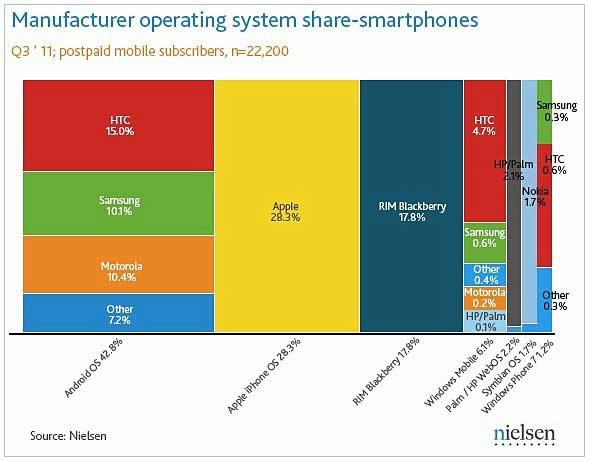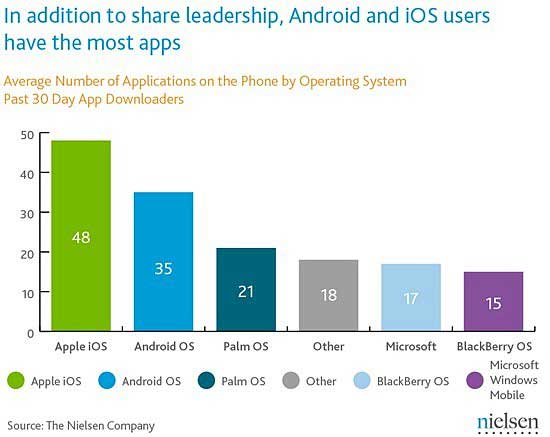Consumers who own Apple iPhones and Google Android devices constitute the majority of the smartphone and mobile app user segments in the US, according to new data from Nielsen.
Among US smartphone users who have downloaded an app in the previous 30 days, 83% use an iPhone or Android phone.
The two vendors dominate the smartphone market overall: Among US smartphone users, more than seven in ten (71%) own an Android device (42.8%) or an iPhone (28.3%), whereas fewer than one in five own a RIM Blackberry (17.8%).

Though Android is the dominant smartphone platform in the US, both Google and Apple continue to spar over dominance in the apps market.
Apple iOS Users Have More Apps
App downloaders with Apple iOS and Android OS smartphones have more apps on their devices than those with other kinds of smartphones, according to April 2011 data from Nielsen: iPhone owners have an average of 48 apps on their devices and Android owners have 35 apps.

By comparison, app downloaders with Blackberry RIM smartphones have 15 apps on average on their devices.
Android Beats iOS in Mobile App Downloads
But Android's widening lead in the smartphone market has driven, at least in part, its new dominance in the apps marketplace, according to ABI Research.
As of the second quarter of 2011, Android captured a leading 44% share all mobile app downloads, surpassing Apple's iOS, which grabbed 31%.
Growth in iPhone shipments fell to 9% in 2Q11, from 15% in the 1Q11, while Android's shipment growth rose to 36% in 2Q11, from 20% in 1Q11. Android's total install base now outweighs iOS by a factor of 2.4:1, ABI said, a ratio forecast to reach 3:1 by 2016.
Apple Still Leads in Downloads per User
However, though Android may be No. 1 in total app downloads, Apple holds the lead in the number of downloads per user: Android's app downloads per user still lag behind Apple's by 2:1, ABI notes.
But Android's open-source strategy is also driving app downloads: "Being a free platform has expanded the Android device install base, which in turn has driven growth in the number of third party multiplatform and mobile operator app stores," said Lim Shiyang, ABI research associate. "These conditions alone explain why Android is the new leader in the mobile application market."
Looking for great digital marketing data? MarketingProfs reviewed hundreds of research sources to create our most recent Digital Marketing Factbook (May 2010), a 296-page compilation of data and 254 charts, covering email marketing, social media, search engine marketing, e-commerce, and mobile marketing. Also check out The State of Social Media Marketing, a 240-page original research report from MarketingProfs.
Overall Apps Market Forecast
The number of annual mobile downloads is forecast to grow from 10.7 billion in 2010 to 182.7 billion by 2015, according to research firm IDC.
The bigger story behind the numbers, IDC noted, is an impending shift away from the current reliance on mobile app download purchases as the primary focus of app monetization.
Instead, developers are expected to focus increasingly on in-app purchasing and advertising to fund business models, a shift the firm found most evident in the free-app category.



